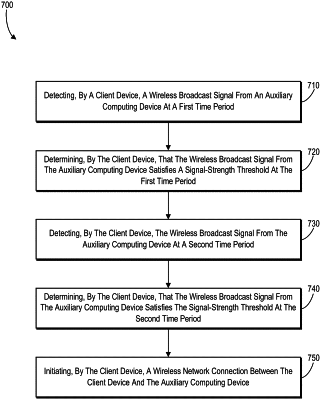| CPC H04W 76/14 (2018.02) [H04B 17/318 (2015.01); H04W 4/022 (2013.01); H04W 12/50 (2021.01); H04W 12/63 (2021.01)] | 20 Claims |

|
1. A non-transitory computer readable medium storing instructions thereon that, when executed by at least one processor, cause a provider client device to:
detect a plurality of wireless broadcast signals from a plurality of auxiliary computing devices at a first time period at a first location, each wireless broadcast signal comprising a particular device identifier for a particular auxiliary computing device;
determine that a wireless broadcast signal from the plurality of wireless broadcast signals satisfies a signal-strength threshold at the first time period by determining that the wireless broadcast signal corresponds to a strongest wireless broadcast signal from among the plurality of wireless broadcast signals at the first time period, the wireless broadcast signal comprising a device identifier for an auxiliary computing device within a transportation vehicle from among the plurality of auxiliary computing devices;
determine at a second time period that the provider client device has traveled within the transportation vehicle to a second location that is a threshold distance from the first location;
detect the wireless broadcast signal from the auxiliary computing device within the transportation vehicle when the provider client device is within the transportation vehicle and located at the second location at a second time period;
determine that the wireless broadcast signal from the auxiliary computing device satisfies the signal-strength threshold at the second time period; and
based on determining that the wireless broadcast signal from the auxiliary computing device satisfies the signal-strength threshold at the first time period corresponding to the first location and the second time period corresponding to the second location, initiate a wireless network connection between the provider client device and the auxiliary computing device within the transportation vehicle.
|